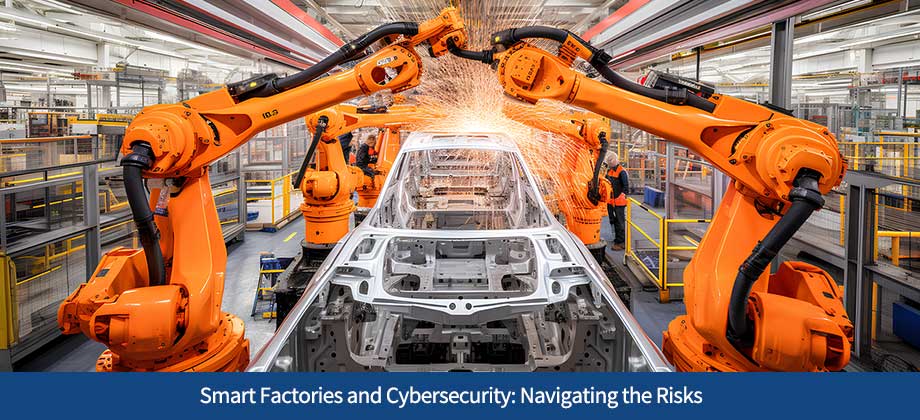Smart Factories and Cybersecurity: Navigating the Risks

In today’s rapidly evolving digital landscape, smart factories have emerged as a key driver of innovation and growth in the manufacturing industry. However, with this new wave of technology comes inherent risks and challenges, particularly in the realm of cybersecurity.
An overwhelming 48% of manufacturers surveyed by Deloitte highlighted operational risks, including cybersecurity, as the greatest threat to smart factory initiatives. This underscores the critical importance of addressing the cyber vulnerabilities that arise when smart factory technologies interconnect, potentially exposing people, technology, processes, and intellectual property to substantial risks.
As we navigate the complex and ever-changing landscape of smart factories, it is paramount that the manufacturing industry bolsters its cybersecurity programs to effectively combat these expanding risks. Only by proactively implementing robust security measures can we safeguard the future of smart manufacturing.
Cyber Threats in Manufacturing: The Growing Danger
As manufacturing companies embrace connectivity, they are also facing a surge in cyber-related incidents linked to the control systems that manage industrial operations. These systems, encompassing programmable logic controllers, distributed control systems, embedded systems, and industrial IoT devices, collectively form the operational technologies (OT) crucial for facility operations.
While connectivity offers advantages like increased productivity, rapid defect identification, and improved collaboration, it also introduces vulnerabilities to smart factories. Startlingly, the Cybersecurity and Infrastructure Security Agency (CISA) has documented over 1,200 known security issues, vulnerabilities, and exploits across OT systems. These issues originate from 300+ original equipment manufacturers (OEMs) and system providers. The digital transformation and adoption of advanced technologies have substantially expanded the threat landscape for production facility control systems.
The Root Cause: IT and OT Misalignment
To enhance operational efficiency and customer service, manufacturers seek to align their IT and OT environments. However, overlapping areas involving people, processes, and technology between these ecosystems often lack synchronization. The reality is that the deployment and usage of these technologies can significantly differ.
Leadership primarily within operations, rather than corporate IT and security departments, typically make OT investment decisions on the factory floor. This results in a multitude of technologies, each with varying security controls, that need integration into existing IT network infrastructures.
By addressing these challenges and bridging the gaps between IT and OT, manufacturers can proactively tackle cyber threats and secure their operations effectively.
Adding advanced technologies to OT networks necessitates an equally sophisticated cybersecurity approach. However, many manufacturers have yet to develop the necessary cyber capabilities to safeguard their critical systems. This becomes particularly problematic as new threats emerge alongside the rapid adoption of smart factory use cases.
While 90 percent of surveyed manufacturers claim to possess detection capabilities for cyber events, few have extended their monitoring into OT environments. Moreover, less than half of the manufacturers have performed cybersecurity assessments within the past six months.
These responses highlight a potential disparity between manufacturers’ confidence in their cyber preparedness and the actual maturity and capabilities required to effectively respond to and recover from cyberattacks, especially with the integration of new technologies. It is plausible that some manufacturers are unaware of the emerging threats posed by leveraging IoT devices and other technologies within a smart factory environment.
As smart factory initiatives continue to expand, the associated cyber risks are expected to increase. The 2019 Deloitte and MAPI Smart Factory Study emphasizes that the current level of cyber preparedness among manufacturers may not sufficiently protect against both existing and emerging threats posed by digital technologies. To address this, manufacturing organizations should invest in a comprehensive cyber management program that spans across the entire enterprise, encompassing both IT and OT, to effectively identify, protect, respond to, and recover from cyberattacks.
To begin building an effective manufacturing cybersecurity program, manufacturers should consider the following steps:
1. Perform a cybersecurity maturity assessment.
2. Establish a formal cybersecurity governance program that includes OT considerations.
3. Prioritize actions based on risk profiles.
4. Integrate security measures throughout the manufacturers’s infrastructure.
By adopting this approach, manufacturing organizations can enhance their cyber resilience and mitigate the evolving cyber risks associated with smart factory operations.
Your privacy is important to us. ARF Financial will never sell or rent your information to any third party. Click here for more information about our privacy policy.

